Nothing About Us Without Us
Developing Innovative Technologies
For, By and With Disabled Persons
PART FOUR
WHEELS TO FREEDOM
CHAPTER 33
Bars for Beno, and a Walker
that Turns into Crutches for Lino
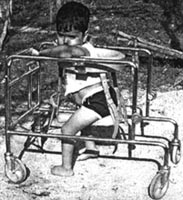
This chapter looks at walking aids, harmful and helpful, for two children with spina bifida: Beno and Lino.
A Costly Walker for Beno that Did More Harm Than Good
BENO was four-years-old when he proudly showed the PROJIMO team how well he could walk with his big new chrome-plated walker. A month before his family (from a fishing village near the coastal city of Mazatlan) had taken him to a rehabilitation hospital where a doctor had prescribed the giant walker. It had cost the family a third of its year's earnings. But was it good for Beno?
Mari and Conchita had their doubts. The big square walker had a sling seat. To push it, the boy sat leaning forward with his hips bent almost at a right angle to his back. This was not a desirable position for a child with spina bifida, like Beno.
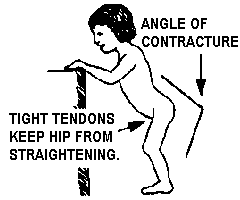
A child with spina bifida (page 131) often has weak muscles in the lower back and hips. This weakness is likely to lead to hip contractures that prevent the hips from straightening. As a result, many of these children have trouble standing up straight (or even lying down straight). Their butt tends to stick out backwards. If they will ever be able to walk upright and independently, they need exercises, activities, and assistive equipment that help stretch and straighten the hips.
Beno's big metal walker did just the opposite. Taking steps while seated in it, he was crouched in a position that would add to hip contractures, not prevent them! Also, walking in a sitting position prevented Beno from bearing weight on his legs, which is important for bone growth and muscle development.
Mari and Conchita explained all this to Beno's parents, and advised them not to let Beno continue using the walker.
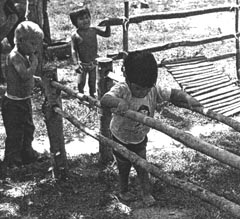
Parallel bars. As an alternative, Conchita adjusted the parallel bars in the playground high enough so that when Beno walked between them, they helped him to stretch his hips and to stand as straight up as possible. The parallel bars, which were made out of poles from the forest, had the advantage that the family could build their own at home at almost no cost.
Later, PROJIMO workers designed a wooden walker for Beno to help him stand as upright as possible and stretch his hip-flexor muscles. (An unusual walker for another child with spina bifida is illustrated on the next page.)
A Low-Cost Crutch-Walker for Lino
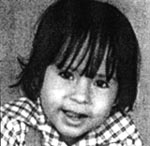
LINO, like Beno, was born with spina bifida. The defect in his spinal cord was sufficiently low on his back (near his butt) that he had fair upper leg strength. This meant he had a good chance of learning to walk, first perhaps with a standing board (parapodium) and then with a walker and perhaps crutches.
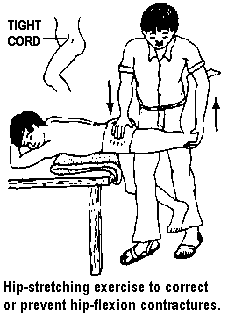
If a child with spina bifida is to be able to walk with crutches, or possibly without them, it is important that, from early childhood, every effort be made to prevent hip-flexion contractures. Care should be taken to keep the hip joints extended as straight as possible by means of exercises, positioning, and appropriate assistive devices.
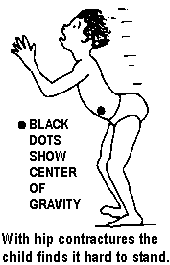
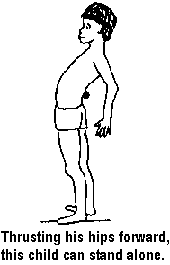
Because of weak lower back and hip muscles, the child with spina bifida is likely to find it hard to stand independently.
Some of these children learn to stand by thrusting their hips forward and their upper body backwards, so that their center of gravity is behind the hips. But to stand this way, it is essential that hip-flexion contractures be prevented (or corrected). In fact, it helps if the hip joints over-extend, or bend farther back than a simply straight position.
Lino was fortunate because, since early childhood, his family helped with exercises and positioning to keep his hips fully flexible. When he was three, PROJIMO helped him start to use a walker, with confidence that he would soon "graduate" to walking with crutches.
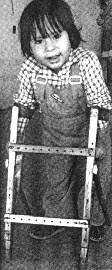
In designing a walker for Lino, Marcelo - an innovative shop-worker at PROJIMO - recalled his own childhood as a boy with both legs paralyzed by polio. Many disabled children who are learning to walk first use a walker and then, when they become a little more stable, change to crutches. For many children, the transition from walker to crutches is a fearful and traumatic experience. The walker gives them substantial stability. Crutches, at first, tend to wobble all over. In learning to use them, the terrified child often loses his balance and takes some nasty falls.
For this reason, Marcelo designed for Lino a walker that could gradually be converted into crutches, with no sudden and frightening transition. The walker consisted of 2 forearm crutches, which were connected with cross struts held in place with bolts and butterfly nuts. This way, the bolts could be gradually loosened to make the walker more wobbly and less stable. Then one after another of the cross-pieces and back-supports could be removed, until only the crutches were left.
This kind of innovation, which takes into consideration the child's worries and fears, is much more likely to take place when the technicians themselves are disabled.
Nothing About Us Without Us
Developing Innovative Technologies
For, By and With Disabled Persons
by David Werner
Published by
HealthWrights
Workgroup for People's Health and Rights
Post Office Box 1344
Palo Alto, CA 94302, USA
